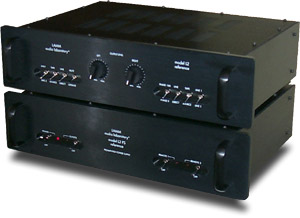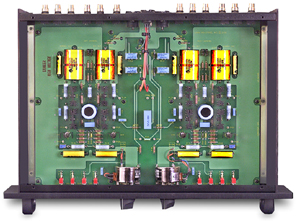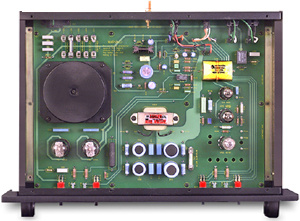![[SoundStage!]](../titles/sslogo3.gif) Home
Audio Home
Audio Equipment Review |
|||||||||||||||||||
Because of the venerable nature of products like the M1.1 monoblocks and their run of eight years without being upgraded or changed in any way, new products from Vladimir Lamm at Lamm Industries are greeted with anticipation from audiophiles -- those who can afford them anyway. When I first received the ML2 SET amps for review, I received weekly e-mail asking when the review would appear. This same thing happened when I received the L2, but then my schedule filled up and I wasn't able to produce the review as quickly as I wanted. So the L2 sat on our list of upcoming reviews, an e-mail message trickling in every month or so until, I'm sure, people wondered if the review would ever appear. Well, it's finally here. But maybe I should fall back on the amount of time needed to produce a review of a product like the L2, which is Lamm's first Reference component. This tag denotes that the L2 is as good a preamp as Vladimir Lamm can design, and it's a good thing given that the L2 costs $13,690 USD. Outwardly, what you get for that substantial sum is a fully class-A line-stage preamp with dual stepped attenuators, RCA and XLR (truly balanced) outputs, RCA inputs, remote switching for Lamm M1.1 and M2.1 amps, and a separate power supply. Of course, this description only scratches the surface. The L2 is actually a hybrid design -- solid-state output stage and tube-rectified and -regulated power supply. It is also dual mono all the way to its power supply, hence the two stepped attenuators, which come from TKD and are costlier by far than even the ALPS Black Beauty attenuators used in the Lamm L1 preamp. The control unit and power supply each measure 4 1/2"H x 19"W x 13 7/8"D and weigh 15 and 19 pounds respectively. They connect to each other via a detachable umbilical. The tubes used in the L2's power supply are a 12AX7, 6C19P and 5651A, and a pair of 12AX3s. The L2's parts are typical of Lamm products: Dale metal-film resistors, Electrocube and Roederstein film caps, Cornell Dubilier electrolytic caps, and Neutrik XLR connectors. The L2's power supply features a custom-designed toroidal transformer, a choke filter, and a power-line filter that cleans incoming AC -- although I used the preamp with a PS Audio P300 and Shunyata Hydra to great musical effect.
As veteran SoundStage! readers know, Vladimir Lamm designs his product based on a model of "the human hearing mechanism" that he's developed, not on any listening he does himself. I wrote about this approach a few years ago in an informational sneak peek; since that time, I've heard every product that Lamm has produced, although this streak will be broken when his soon-to-be-available phono stage hits the market -- I'm all digital and haven't looked back. System I used the L2 with my Lamm ML2 amplifiers, of course, but because it has balanced outputs, I also used it with a pair of Audio Research VTM200 mono amps, which only accept such input. Speakers were Wilson Audio WATT/Puppy 6es. The main comparison piece on hand was the Lamm L1, which I've been using as my reference since I reviewed it way back in November 1997. Source components were a Mark Levinson No.39 CD player run into the L2 and directly into the amps to test Lamm's claim that the L2 has an "almost inaudible sonic signature." I also used a Bel Canto DAC1.1 driven by the No.39 or a Pioneer DV-525 DVD player. I had a number of sets of cables at my disposal, including Transparent Reference XL, JPS Labs Superconductor2 and NC Series, TARA Labs Air One, Nordost Quattro-Fil and SPM Reference, and DH Labs Q-10 and Air Matrix. I settled on the Nordost and Transparent cables, although the two certainly didn't sound alike (I'll comment on this in an upcoming review). Power cords were from TARA Labs (The One and RSC Air) or Shunyata Research (just about the entire PowerSnakes line). I used a PS Audio P300 with MultiWave, Richard Gray's Power Company 400S, or a Shunyata Hydra for power-feeding duties. The amps sat on Bright Star Big Rock bases, as did the Levinson No.39 (with a Townsend Seismic Sink in between). I didn't tweak the L2 much, putting its two chassis on top of my Target equipment racks. The top shelves of the racks are made of Corian and rest on upturned spikes, so they're isolated. I experimented greatly with power cords, preferring a Shunyata Viper V2 with the L2, for which it seemed ideally suited. I wondered thereafter how an umbilical from power supply to preamp of the same cord would work -- and if it was feasible given the Viper V2's girth and build. The L2's two chassis are rather resonant, so I loaded their top plates with sand bags and noticed a mild increase in focus. Adding some Cromolin VC damping material inside each chassis may improve performance too. Interestingly, the PS Audio P300 caused the L2's power supply to hum rather audibly with certain MultiWave waveforms. No other products with which I used the P300 were affected in the same way. I won't speculate if this means anything about the L2, but I did consider it a sign that the MultiWaved P300 was certainly doing something with each change of waveform. Et tu L2? As I've mentioned, the Lamm L1 has been my reference preamp for years. Its utter naturalness and synergy with Lamm amplifiers, which I've used just as long, have become constants that I just can't do without. Like the L2, the L1 has dual attenuators, but in the L1's case, there's also a master volume control, so there's no need to count "clicks" when adjusting the volume. With the L2, Vladimir Lamm preferred to emphasize circuit purity over convenience, which is also the reason no Lamm preamp is remote controlled. "Bad for sound," says Vlad. "So be it," is my response. I'll take the sound of the L1 over convenience, although I still long for remote control. But even with its dual attenuators, the L2 is a snap to use. Front-panel toggle switches allow you to choose inputs, including a Direct input that bypasses much of the switching, and adjusting the volume is a simple matter of counting the very prominent "clicks" of the L2's attenuators, 41 positions in all. I found that the L2 needed about 50 hours of run-in, before which it sounded shrill and tizzy. I just left it on for a couple of days playing music, putting some time on the tubes and other parts. Lamm runs in each L2 for 72 hours before shipping it, and as is the Lamm way, Vladimir Lamm also takes measurements of each unit before it leaves, a copy of which you receive with your preamp. Once I sat down to do some serious listening to the L2, I was quickly surprised at how similar it sounded to the L1. But then what else should I have expected? Both preamps use similar hybrid circuits and are designed by the same man. So right from the beginning, I was familiar with much of what the L2 did, and the Lamm lexicon of reviewing terms and phrases came quickly to mind: balanced, organic, natural, able to play loud and only get louder with an increase in volume. As a quick assessment, the L2 sounds like a detailed and exceedingly smooth solid-state preamp with a touch of tube ease and romanticism. This is accurate in terms of the L2's hybrid circuitry, but I wasn't expecting it to be its sonic signature too -- or so closely resemble the sound of the L1. The various JVC XRCDs that I have were the perfect discs to enjoy with the L2 in my system, their traits matching those of the L2 so closely. Their presence and sweetness, neither coming at the expense of detail, make them very satisfying sonically, and the choice of material to remaster is inspired. I've recently reviewed Art Pepper's Meets the Rhythm Section [Victor VICJ60087] and +Eleven [Victor VICJ-60245], but my favorite recent XRCD remaster is Lightnin' Hopkins' Goin Away [JVC JVCXR-0211-2]. It's stunning because of its intimacy and fine detail, as with the slight resonance of the guitar's body and slap of the drums on "Stranger Here." And the depth of Hopkins' guitar on the title track is audiophile candy -- he sits four feet behind my speakers, seemingly behind the front wall! The L2's ability to convey the humanness of Hopkins' singing is obvious -- he's in the room in voice and spirit -- but it also displays all of the small touches of the recording, which is what you want from your system if you're going to spring for an XRCD. Great stuff. Spacious recordings like G. Love and Special Sauce [Okeh/Epic EK 57851] as well as certain cuts on Emmylou Harris' Red Dirt Girl [Nonesuch 79616-2] ("Michangelo" comes quickly to mind) seem all the more so with the L2. The L2's ability to convey spatial information, much of which resides in the treble range, is as good as I've heard, as is the clarity of its treble. Brass and guitar have the steeliness characteristic of both, but the treble also has a lilting, easy quality that won't induce fatigue and shorten your listening sessions. A CD that demonstrates this is Frente!'s Marvin the Album [Mammoth 92390-2]. Angie Hart, the band's lead singer, has the most delicate voice I've heard. She's childlike in her upper range -- thinner, seemingly singing more from her sinuses than her chest. And as Hart's vocals trail, they reside firmly in the lower-treble range, a trouble zone for components whose high end is less refined than that of the L2. Hart is captured with tremendous tenderness and aching beauty; a visual analogy would be the way you experience a sunset in the desert, the sun ducking ever so slowly behind the horizon until there is only the slightest afterglow to remind you of what you just saw. The L2 does the same thing, its highs trailing off with complexly satisfying results. The L2's treble is truthful and intensely musical, these seeming to be at odds until you hear how they mix. It's in the mids that you'll know the L2 isn't an all-tube preamp; there isn't any tube bloom or obvious warmth. But there isn't any solid-state hardness or whiteness either, the mids sounding ever so slightly laid-back, but tonally neutral. I find singer/songwriter Greg Brown's voice to be the perfect midrange test. If Brown sounds dark and overly dusky, a component's midrange is more full than neutral. If he starts to sound throaty, then the midrange is really off -- and too thin. Brown is perfect with the L2 -- chesty but not thick. On "Loneliness House" from Slant Six Mind [Red House RHR CD 98], Brown growls in spots, and the L2 captures it, down to the back-of-the-throat spittiness -- not a pleasant thing to think about, but it's there. On Further In [Red House RHR CD 88], a warmer-sounding disc, Brown is chesty throughout. The L2 reproduces this -- you'll be aware of it for sure -- but you'll also know the recording's contribution. The L2's midrange has no obvious tendencies or deficiencies. The L2's bass is honest, not overblown or light, although the slightest bit plumy in absolute terms. Rather self-effacing until something slamming is played, the L2's low end doesn't suffer from overhang, bloat or any other malady of excess. But then on cuts like "Joe Slam and the Space Ship" from Harry Connick Jr.'s She [Columbia CK 64376], the Wilson WATT/Puppy 6 speakers prove to be the limiting factor, even their dual 8" woofer running out of steam. But don't think light or rhythmically challenged. Discs like Medeski Martin and Wood's Shack-man [Gramavision GCD 79514] or the great XRCD reissue of Wynton Kelly's Piano [Victor VICJ-60259] are driving and powerful where they should be. Piano, in particular, was impressive with the L2 in use, even though it was recorded over 40 years ago. Upon hearing Lamm's less expensive LL2 preamp, I was instantly struck by the power of its bass --it was more prominent than that of the L2, and may even be more powerful to boot. But for the price of a preamp like the L2, you should expect balance, no region more conspicuous than any other. And the L2 delivers on this, as it should. Using the Mark Levinson No.39 directly into the amps, both single ended and balanced, shows the L2 to be a notably transparent preamp. Oh, it's there all right, but its sound is less editorial than that of the L1, for instance, and I would bet less than that of many other preamps too. It adds a little sweetness and ease that are not unwelcome, to my ears at least. No, it's not a straight wire with gain, but no preamp I've heard is -- and I think this is a theoretical goal anyway. We need preamps, and want them to preserve what's on our recordings. I ran the No.39 into the L2 via the volume control and then with the line-level output fixed, and this showed that even the No.39's minimal volume control has a character. In terms of comparison, as I've already stated, the L2 and L1 sound very similar, more like each other than any two preamps I can recall. However, the L2 shows why it costs more -- in its treble, which is more open and extended, and its bass, which goes lower but doesn't necessarily have more weight. But why does it cost double the price? It's one of those audio things -- you can get most of the way there by spending relatively little money (relatively -- this is high-end audio, after all), but making the push for the summit is something you have to pay for dearly. I've lived happily with the L1, which is costly enough, but the L2 is better in such important ways that hearing it makes me want it. Conclusion I've told you about how the Lamm L2 Reference sounds, but none of this matters as much as the way it makes me apathetic about its sonic traits. Yes, it serves the music and gets out of its way too -- more theoretical goals -- but it's a piece of equipment into which I was glad to settle for long, long listening sessions. We've all known people whose personalities were easy to describe, but being able to do this doesn't make them any more engaging (and sometimes ruins their allure). The L2 is, instead, like an old friend, one whose company I valued without thinking about it (which is what makes a person an old friend, come to think of it). With the L2, I immediately recognized the Lamm sound, which I know well, but it also struck me as being more complete than that of the L1, and this makes the L2 the most musically satisfying preamp I've heard. But I can imagine the e-mail I'll be getting: "The thing costs almost $14,000! For that kind of money, it should have four wheels and a sun roof." But equipment like the Lamm L2 is not for those of us who are apt to think about its high cost, period. It's for those who are chasing the best reproduction that money can buy, and have a load of money with which to buy it. I suspect that a good many owners of Lamm amps and even the Lamm L1 preamp will buy the L2, and these are the kind of ultra-discerning audiophiles for whom the L2 was created. As I sum up, I wonder if I've conveyed strongly enough how significant the Lamm L2 Reference preamp is. I've lived with the L1 for so long that the L2 was not startling by comparison. I would have liked to compare the L2 to a CAT Ultimate or the Conrad-Johnson ART, neither of which I had at my disposal. Until that time comes -- if it comes -- I'll consider the L2 to be at the top of the preamplifier heap. And if this is the kind of preamp you're after, I suggest you give the Lamm L2 Reference a careful listen. ...Marc Mickelson
|
|||||||||||||||||||
|
|||||||||||||||||||
![[SoundStage!]](../titles/sslogo3.gif) All
Contents All
ContentsCopyright © 2001 SoundStage! All Rights Reserved |



